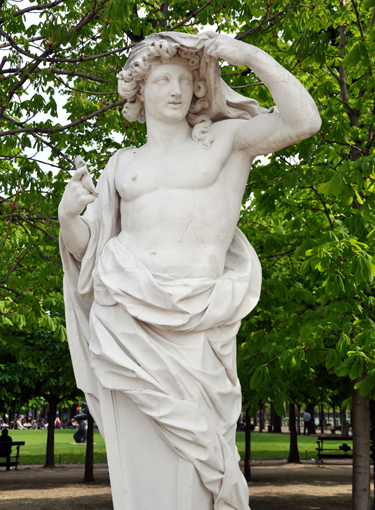Artist:
Francois Barois
Title:
Automne
Year:
1696
Adress:
Jardin des Tuileries
www.wikipedia.org:
François Barois (1656, Paris - 1726, Paris) est un sculpteur français, actif sous le regne de Louis XIV puis sous la Regence.
François Barois tente le prix de Rome en 1682, avec Caïn bâtit la ville d'Enoch, mais echoue a la seconde place (le gagnant est Nicolas Coustou). Il execute tout de meme un sejour a Rome entre 1683 et 1686, periode pendant laquelle il realise une copie de la Venus callipyge de la collection Farnese (Paris, musee du Louvre). Apres son retour en France, il est reçu a l'Academie royale de peinture et de sculpture en 1700 sur presentation d'une Cleopâtre mourant (Paris, musee du Louvre). Il entame alors une brillante carriere officielle. Entre 1706 et 1709, il sculpte une Pomone (Paris, musee du Louvre) pour la cascade rustique de Marly. Il travaille egalement a la decoration des jardins de Versailles et pour Trianon : termes representant Vertumne et Pomone (Paris, musee du Louvre), et realise La Foi pour orner le toit de la chapelle royale.
Translation
François Barois (1656 Paris - 1726 Paris) was a French sculptor active during the reign of Louis XIV then under the Regence.
François Barois attempts the Rome Prize in 1682, with Cain built the city of Enoch, but fails in second place (the winner is Nicolas Coustou). It runs still stay in Rome between 1683 and 1686, during which he produced a copy of the Venus callipyge from the Farnese collection (Paris, Louvre). After returning to France, he was admitted to the Royal Academy of Painting and Sculpture in 1700 on presentation of a dying Cleopatra (Paris, Louvre). He then started a brilliant official career. Between 1706 and 1709 he sculpted a Pomona (Paris, Louvre) for the rustic cascade Marly. It also works to decorate the gardens of Versailles and Trianon terms representing Vertumnus and Pomona (Paris, Louvre), and realizes Faith to adorn the roof of the Chapel Royal.
François Barois (1656, Paris - 1726, Paris) est un sculpteur français, actif sous le regne de Louis XIV puis sous la Regence.
François Barois tente le prix de Rome en 1682, avec Caïn bâtit la ville d'Enoch, mais echoue a la seconde place (le gagnant est Nicolas Coustou). Il execute tout de meme un sejour a Rome entre 1683 et 1686, periode pendant laquelle il realise une copie de la Venus callipyge de la collection Farnese (Paris, musee du Louvre). Apres son retour en France, il est reçu a l'Academie royale de peinture et de sculpture en 1700 sur presentation d'une Cleopâtre mourant (Paris, musee du Louvre). Il entame alors une brillante carriere officielle. Entre 1706 et 1709, il sculpte une Pomone (Paris, musee du Louvre) pour la cascade rustique de Marly. Il travaille egalement a la decoration des jardins de Versailles et pour Trianon : termes representant Vertumne et Pomone (Paris, musee du Louvre), et realise La Foi pour orner le toit de la chapelle royale.
Translation
François Barois (1656 Paris - 1726 Paris) was a French sculptor active during the reign of Louis XIV then under the Regence.
François Barois attempts the Rome Prize in 1682, with Cain built the city of Enoch, but fails in second place (the winner is Nicolas Coustou). It runs still stay in Rome between 1683 and 1686, during which he produced a copy of the Venus callipyge from the Farnese collection (Paris, Louvre). After returning to France, he was admitted to the Royal Academy of Painting and Sculpture in 1700 on presentation of a dying Cleopatra (Paris, Louvre). He then started a brilliant official career. Between 1706 and 1709 he sculpted a Pomona (Paris, Louvre) for the rustic cascade Marly. It also works to decorate the gardens of Versailles and Trianon terms representing Vertumnus and Pomona (Paris, Louvre), and realizes Faith to adorn the roof of the Chapel Royal.



